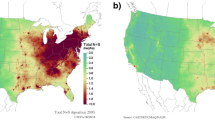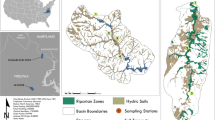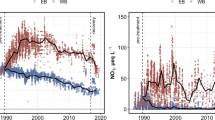Abstract
Impacts from acidic deposition on stream water quality in the Great Smoky Mountains National Park (GRSM) have long been reported; however, a better understanding of the biogeochemical processes that regulate stream acidification is needed for resource management. Water quality monitoring of Noland Divide Watershed (NDW), a high-elevation watershed in the GRSM, was used to generate an ion input–output budget in order to evaluate what processes have influenced stream pH and acid neutralizing capacity (ANC) over the long term. NDW was equipped with wet deposition, throughfall, soil lysimeters, and stream collection stations, and monitoring began in 1991 and continues to the present. Using data from 1991 to 2006, this study found annual deposition fluxes of SO4 2− and NO3 − averaged 1,735 and 863 eq ha−1 year−1, respectively. Data indicated that 61% of the net SO4 2− entering the watershed was retained, suggesting soil adsorption dominates as a biogeochemical process. Although net SO4 2− retention was observed, SO4 2− appeared to move rapidly through NDW during large precipitation events causing stream acidification, as evidenced by significant inverse correlations between biweekly throughfall SO4 2− flux and stream event pH and ANC. Nitrogen uptake by forest vegetation and nitrification play key roles in regulating NO3 − export to the stream as observed by 32% retention of net inorganic nitrogen, and 96% of NH4 + input was converted to NO3 − in the uppermost soil horizon. Net export of base cations (Ca2+, Mg2+, Na+) is observed and apparently moderates stream acidification. In contrast, 71% of net K+ input was retained, which is likely due to forest vegetation uptake. Net export of Ca2+ was 867 eq ha−1 year−1 compared to net throughfall of 790 eq ha−1 year−1. Long-term cation depletion from the NDW soils could limit recovery potential in stream water quality. Findings from this NDW study suggest that future stream acidification conditions in high-elevation GRSM watersheds are dependent on interrelated biogeochemical processes and precipitation patterns, illustrating the need to better understanding potential impacts of climate variability on stream water quality.




Similar content being viewed by others
References
Aherne, J., Larssen, T., Cosby, B. J., & Dillon, P. J. (2006). Climate variability and forecasting surface water recovery from acidification: Modeling drought-induced sulphate release from wetlands. Science of the Total Environment, 365, 186–199.
Barker, M., Van Miegroet, H., Nicholas, N. S., & Creed, I. F. (2002). Variation in overstory nitrogen uptake in a small, high-elevation southern Appalachian spruce-fir watershed. Canadian Journal of Forest Research, 32, 1741–1752.
Cai, M., & Schwartz, J.S. (2008). WinHSPF Model simulations of nitrogen and pH for a low-alkalinity stream impacted from atmospheric acid deposition. 2008 World Water and Environmental Resources Congress. American Society of Civil Engineers, Reston, VA
Cape, J. N., Sheppard, L. J., Fowler, D., Harrison, A. F., Parkinson, J. A., Dao, P., et al. (1992). Contribution of canopy leaching to sulfate deposition in a Scots pine forest. Environmental Pollution, 75, 229–236.
Castro, M. S., & Morgan, R. P., II. (2000). Input–output budget of major ions for a forested watershed in Western Maryland. Water, Air, and Soil Pollution, 119, 121–137.
Chen, L., Driscoll, C. T., Gbondo-Tugbawa, S., Mitchell, M. J., & Murdoch, P. S. (2004). The application of an integrated biogeochemical model (PnET-BGC) to five forested watersheds in the Adirondack and Catskill regions of New York. Hydrological Processes, 18, 2631–2650.
Cook, R. B., Elwood, J. W., Turner, R. R., Bogle, M. A., Mulholland, P. J., & Palumbo, A. V. (1994). Acid–base chemistry of high-elevation streams in the Great Smoky Mountains. Water, Air, and Soil Pollution, 72, 331–356.
Dambrine, E., Pollier, B., Poszwa, A., Ranger, J., Probst, A., Viville, D., et al. (1998). Evidence of current soil acidification in spruce stands in the Vosges Mountains, north-eastern France. Water, Air, and Soil Pollution, 105, 43–52.
Deviney, F. A., Rice, K. C., & Hornberger, G. M. (2006). Time series and recurrence interval models to predict the vulnerability of streams to episodic acidification in Shenandoah National Park, Virginia. Water Resources Research, 42, W09405.1–W09405.14. doi:10.1029/2005WR004740.
Deyton, E. B., Schwartz, J. S., Robinson, R. B., Neff, K. J., Moore, S. E., & Kulp, M. A. (2009). Characterizing episodic stream acidity during stormflows in the Great Smoky Mountains National Park. Water, Air, and Soil Pollution, 196, 3–18.
Dow, C. L., & DeWalle, D. R. (1997). Sulfur and nitrogen budgets for five forested Appalachian plateau basins. Hydrological Process, 11, 801–816.
Draaijers, G. P. J., & Erisman, J. W. (1995). A canopy budget model to assess atmospheric deposition from throughfall measurements. Water, Air, and Soil Pollution, 85, 2253–2258.
Draaijers, G. P. J., Erisman, J. W., Van Leeuwen, N. F. M., Romer, T. E., Winkel, B. H., Veltkamp, A. C., et al. (1997). The impact of canopy exchange on differences observed between atmospheric deposition and throughfall fluxes. Atmospheric Environment, 31(3), 387–398.
Driscoll, C. T., Baker, J. P., Bisogni, J. J., & Schofield, C. L. (1980). Effect of aluminum speciation on fish in dilute acidified waters. Nature, 284, 161–164.
Driscoll, C. T., Lawrence, G. B., Bulger, A. J., Bulter, T. J., Cronan, C. S., Eagar, C., et al. (2001). Acidic deposition in the northeastern United States: Sources and inputs, ecosystem effects, and management strategies. BioScience, 51(3), 180–197.
Driscoll, C. T., Likens, G. E., & Church, M. R. (1998). Recovery of surface waters in the northeastern U.S. from decreases in atmospheric deposition of sulfur. Water, Air and Soil Pollution, 105, 319–329.
Essington, M. E. (2004). Soil and water chemistry: An integrative approach. Boca Raton: CRC.
Evans, H. E., Dillon, P. J., & Molot, L. A. (1997). The use of mass balance investigations in the study of the biogeochemical cycle of sulfur. Hydrological Processes, 11, 765–782.
Farrell, E. P., Aherne, J., Boyle, G. M., & Nunan, N. (2001). Long-term monitoring of atmospheric deposition and the implications of ionic inputs for the sustainability of a coniferous forest ecosystem. Water, Air, and Soil Pollution, 130, 1055–1060.
Fernandez, I. J., Rustad, L. E., Norton, S. A., Kahl, J. S., & Cosby, B. J. (2003). Experimental acidification causes soil base cation depletion at the Bear Brook Watershed in Maine. Soil Science Society of America Journal, 67, 1909–1919.
Gobran, G. R., Selim, H. M., Hultberg, H., & Andersson, I. (1998). Sulfate adsorption–desorption in a Swedish forest soil. Water, Air, and Soil Pollution, 108, 411–424.
Groffman, P. M., Fisk, M. C., Driscoll, C. T., Likens, G. E., Fahey, T. J., Eagar, C., et al. (2006). Calcium additions and microbial nitrogen cycle processes in a northern hardwood forest. Ecosystems, 9, 1289–1305.
Hayter, A. J. (1984). A proof of the conjecture that the Tukey–Kramer multiple comparisons procedure is conservative. Annals of Statistics, 12(1), 61–75.
Herlihy, A. T., Kaufmann, P. R., & Mitch, M. E. (1991). Stream chemistry in the Eastern United-States. 2. Current sources of acidity in acidic and low acid-neutralizing capacity streams. Water Resources Research, 27, 629–642.
Holzmueller, E. J., Jose, S., & Jenkins, M. A. (2007). Influence of calcium, potassium, and magnesium on Cornus florida L. density and resistance to dogwood anthracnose. Plant and Soil, 290, 189–199.
Houle, D., Ouimet, R., Couture, S., & Gagnon, C. (2006). Base cation reservoirs in soil control the buffering capacity of lakes in forested catchments. Canadian Journal of Fisheries and Aquatic Sciences, 63, 471–474.
Jin, L., Shao, M., Zeng, L. M., Zhao, D. W., & Tang, D. G. (2006). Estimation of dry deposition fluxes of major inorganic species by canopy throughfall approach. Chinese Science Bulletin, 51(15), 1818–1823.
JMP. (2005). JMP 6 documentation set English. Cary: SAS Institute.
Johnson, D. W., & Lindberg, S. E. (eds). (1992). Atmospheric deposition and nutrient cycling in forest ecosystems: A synthesis of the Integrated Forest Study. New York: Springer.
Johnson, D. W., Van Miegroet, H., Lindberg, S. E., & Todd, D. E. (1991). Nutrient cycling in red spruce forest of the Great Smoky Mountains. Canadian Journal of Forest Research, 21, 769–787.
King, P. B., Neuman, R. B., & Hadley, J. B. (1968). Geological Survey professional paper #587, Washington D.C.
King, H. B., Wang, M. K., Zhuang, S. Y., Hwong, J. L., Liu, C. P., & Kang, M. J. (2006). Sorption of sulfate and retention of cations in forest soils of Lien-Hua-Chi watershed in central Taiwan. Geoderma, 131, 143–153.
Kölling, C., & Prietzel, J. (1995). Correlations between nitrate and sulfate in the soil solution of disturbed forest ecosystems. Biogeochemistry, 31, 121–138.
Lawrence, G. B. (2002). Persistent episodic acidification of streams linked to acid rain effects on soil. Atmospheric Environment, 36, 1589–1598.
Lindberg, S. E., & Lovett, G. M. (1992). Deposition and forest canopy interactions of airborne sulfur: Results from the integrated forest study. Atmospheric Environment, 26(A), 1477–1492.
Löfgren, S., & Kvarnäs, H. (1995). Ion mass balances for three small forested catchments in Sweden. Water, Air, and Soil Pollution, 85, 529–534.
McCracken, R. J., Shanks, R. E., & Clebsch, E. E. C. (1962). Soil morphology and genesis at higher elevations of the Great Smoky Mountains. Soil Science Society of America, 26, 384–388.
Mitchell, M. J., Mayer, B., Bailey, S. W., Hornbeck, J. W., Alewell, C., Driscoll, C. T., et al. (2001). Use of stable isotope ratios for evaluating sulfur sources and losses at the Hubbard Brook experimental forest. Water, Air, and Soil Pollution, 130, 75–86.
Mitchell, M. J., Raynal, D. J., & Driscoll, C. T. (1996). Biogeochemistry of a forested watershed in the central Adirondack Mountains: Temporal changes and mass balances. Water, Air, and Soil Pollution, 88, 355–369.
Mulholland, P. J. (1993). Hydrometric and stream chemistry evidence of three storm flowpaths in Walker Branch Watershed. Journal of Hydrology, 151, 291–316.
National Atmospheric Deposition Program (NADP). (2006). NADP data report 2006–01. Champaign: Illinois State Water Survey.
Neff, K. J., Schwartz, J. S., Henry, T. B., Robinson, B. R., Moore, S. E., & Kulp, M. A. (2009). Physiological stress in native southern brook trout during episodic stream acidification in the Great Smoky Mountains National Park. Archives of Environmental Contamination and Toxicology, 57, 366–376. doi:10.1 107/s00244-008-9269-4.
Pajuste, K., Frey, J., & Asi, E. (2006). Interactions of atmospheric deposition with coniferous canopies in Estonia. Environmental Monitoring and Assessment, 112, 177–196.
Palmer, S. M., Driscoll, C. T., & Johnson, C. E. (2004). Long-term trends in soil solution and stream water chemistry at the Hubbard Brook experimental forest: Relationship with landscape position. Biogeochemistry, 68, 51–70.
Peterjohn, W. T., Adams, M. B., & Gilliam, F. S. (1996). Symptoms of nitrogen saturation in two central Appalachian hardwood forest ecosystems. Biogeochemistry, 35(3), 507–522.
Porter, E., Blett, T., Potter, D. U., & Huber, C. (2005). Protecting resources on federal lands: Implications of critical loads for atmospheric deposition of nitrogen and sulfur. BioScience, 55(7), 603–612.
Shanks, R. E. (1954). Climates of the Great Smoky Mountains. Ecology, 3, 354–361.
Shibata, H., Kirikae, M., Tanaka, Y., Sakuma, T., & Hatano, R. (1998). Proton budgets of forest ecosystems on volcanogenous regosols in Hokkaido, northern Japan. Water, Air, and Soil Pollution, 105, 63–72.
Shubzda, J., Linderberg, S. E., Garten, C. T., & Nodvin, S. C. (1995). Elevational trends in the fluxes of sulphur and nitrogen in throughfall in the Southern Appalachian Mountains, some surprising result. Water, Air, and Soil Pollution, 85, 2265–2270.
Silsbee, D. G., & Larson, G. L. (1982). Water quality of streams in the Great Smoky Mountains National Park. Hydrobiologia, 89, 97–115.
Spratt, H. G. (1998). Organic sulfur and the retention of nutrient cations in forest surface soils. Water, Air, and Soil Pollution, 105, 305–317.
SPSS. (2006). SPSS 15.0 brief guide. Chicago: SPSS.
STORET (2008). STORET Data Warehouse. http://www.epa.gov/storet/dw_home.html.
Sullivan, T. J., Cosby, B. J., Herlihy, A. T., Webb, J. R., Bulger, A. J., Snyder, K. U., et al. (2004). Regional model projections of future effects of sulfur and nitrogen deposition on streams in the southern Appalachian Mountains. Water Resources Research, 40, W02101. doi:10.1029/2003WR001998.
Sullivan, T. J., Cosby, B. J., Webb, J. R., Dennis, R. L., Bulger, A. J., & Deviney, F. A., Jr. (2008). Streamwater acid–base chemistry and critical loads of atmospheric sulfur deposition in Shenandoah National Park, Virginia. Environmental Monitoring and Assessment, 137, 85–99.
Sullivan, T. J., Webb, J. R., Synder, K. U., Herlihy, A. T., & Cosby, B. J. (2007). Spatial distribution of acid-sensitive and acid-impacted streams in relation to watershed features in the southern Appalachian Mountains. Water, Air, and Soil Pollution, 182, 57–71.
Tomlinson, G. H. (2003). Acidic deposition, nutrient leaching and forest growth. Biogeochemistry, 65, 51–81.
Ulrich, B. (1983). A concept of forest ecosystem stability and of acid deposition as driving force for destabilization. In B. Ulrich & J. Pankrath (Eds.), Effects of accumulation of air pollutants in forest ecosystems (pp. 1–29). Dordrecht: Reidel.
USDA-ARS (1979). Field manual for research in agricultural hydrology. In: Agricultural handbook 224. Washington DC: US Department of Agriculture.
Van Miegroet, H., Creed, I. F., Nicholas, N. S., Tarboton, D. G., Webster, K. L., Shubzda, J., et al. (2001). Is there synchronicity in nitrogen input and output fluxes at the Noland Divide Watershed, a small N-saturated forested catchment in the Great Smoky Mountains National Park? TheScientificWorld, 1(S2), 480–492.
Van Miegroet, H., Johnson, D. W., & Todd, D. E. (1993). Foliar response of red spruce saplings to fertilization with Ca and Mg in the Great Smoky Mountains National Park. Canada Journal of Forest Research, 23, 89–95.
Van Miegroet, H., Moore, P. T., Tewksburg, C. E., & Nicholas, N. S. (2007). Carbon sources and sinks in high-elevation spruce-fir forests of the Southeastern US. Forest Ecology and Management, 238, 249–260.
Watmough, S. A., Aherne, J., Alewell, C., Arp, P., Bailey, S., Clari, T., et al. (2005). Sulfate, nitrogen and base cation budgets at 21 forested catchments in Canada, the United States and Europe. Environmental Monitoring and Assessment, 109, 1–36.
Weathers, K. C., Simkin, S. M., Lovett, G. M., & Lindberg, S. E. (2006). Empirical modeling of atmospheric deposition in mountainous landscapes. Ecological Applications, 16(4), 1590–1607.
Welsch, D. L., Burns, D. A., & Murdoch, P. S. (2004). Processes affecting the response of sulfate concentrations to clearcutting in a northern hardwood forest, Catskill Mountains, New York, U.S.A. Biogeochemistry, 68, 337–354.
Wigington, P. J., Jr., DeWalle, D. R., Murdoch, P. S., Kretser, W. A., Simonin, H. A., Van Sickle, J., et al. (1996). Episodic acidification of small streams in the Northern United States: Ionic controls of episodes. Ecological Applications, 6(2), 389–407.
Williard, K. W. J., DeWalle, D. R., Edwards, P. J., & Schnabel, R. R. (1997). Indicators of nitrate export from forested watersheds of the mid-Appalachians, United States of America. Global Biogeochemical Cycles, 11(4), 649–656.
Wright, R. F., Aherne, J., Bishop, K., Camarero, L., Cosby, B. J., Erlandsson, M., et al. (2006). Modeling the effect of climate change on recovery of acidified freshwaters: Relative sensitivity of individual processes in the MAGIC model. Science of the Total Environment, 365, 154–166.
Wright, R. F., Alewell, C., Cullen, J. M., Evans, C. D., Marchetto, A., Moldan, F., et al. (2001). Trends in nitrogen deposition and leaching in acid-sensitive streams in Europe. Hydrology and Earth System Sciences, 5, 299–310.
Yanni, S., Keys, K., Clair, T. A., & Arp, P. A. (2000). Fog and acidification impacts on ion budgets of basins in Nova Scotia, Canada. Journal of the American Water Resources Association, 36(3), 619–631.
Acknowledgments
Research for this project was funded by the US Department of Interior, National Park Service Cooperative Agreement Grant No. 1443-CA-5460-98-006 (Amendment 10) and the US Environmental Protection Agency through the University of Tennessee Natural Research Policy Center, USEPA Grant No. EM-83298901-1. We are thankful for the support of Dr. Nancy Finley, Natural Resource Research Director at the GRSM. Because of the 16-year monitoring effort, the individuals who have helped in sample collection, laboratory analysis, and data management over the years are too numerous to list. In recent years, we are thankful for the support of Tom Barnett, Karen Jackson, Keil Neff, Tom Zimmerman, and Lee Mauney.
Author information
Authors and Affiliations
Corresponding author
Rights and permissions
About this article
Cite this article
Cai, M., Schwartz, J.S., Robinson, R.B. et al. Long-Term Effects of Acidic Deposition on Water Quality in a High-Elevation Great Smoky Mountains National Park Watershed: Use of an Ion Input–Output Budget. Water Air Soil Pollut 209, 143–156 (2010). https://doi.org/10.1007/s11270-009-0187-5
Received:
Accepted:
Published:
Issue Date:
DOI: https://doi.org/10.1007/s11270-009-0187-5




